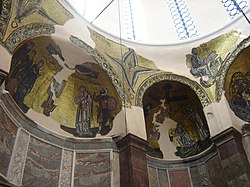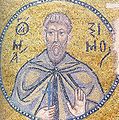Nea Moni
Nea Moni ( Greek Νέα Μονή Néa Moní, 'new monastery') is the name of a Byzantine monastery on the Greek island of Chios . Together with the Daphni Monastery near Athens and the Hosios Lukas Monastery near Delphi, it is one of the three most important Greek sacred buildings of the 11th century and is particularly famous for its mosaics . In 1990, the three monasteries were built as a joint World Heritage Site in the list of World Heritage of UNESCO added. The monastery is dedicated to the Assumption of Mary.
location
The monastery is located in a valley densely forested with cypress trees 15 km west of Chios town between Karyes and Avgonyma.
history
Before the monastery was founded, legend has it that it was replaced by a small church, which was built by three monks who had found an icon of the Blessed Virgin Mary on a myrrh bush in this place .
The monastery was founded in 1042 by the Byzantine Emperor Constantine IX. Monomachus and his wife Empress Zoe donated. Constantine had vowed the icon of St. Theotokos in exile on Lesbos that he would build a monastery at the site of the icon when he became emperor. Constantine IX achieved this through his marriage to the Empress Zoe.
For centuries the monastery was the most important religious center on the island of Chios. It reached the height of its power after the fall of the Byzantine Empire.
The influence and reputation of the monastery remained until 1822, when after the massacre of Chios , which the Ottomans carried out after the unsuccessful Greek uprising, many Chioten sought refuge in the monastery. Most of them were killed, including 600 monks. The victims were buried in the Chapel of the Holy Cross, which is located next to the entrance gate of the monastery. The monastery was badly damaged by arson and devastation.
In 1857, extensive restoration work was carried out on the Katholikon under Abbot Gregorios Photeinos. The church's dome and bell tower collapsed in an earthquake in 1881. The dome was rebuilt in 1900 and the mosaics were restored in the 1960s.
The monastery is currently inhabited by nuns, the small museum of the monastery is housed in a two-story cell building northwest of the Catholicons.
description
The monastery consists of the main church, the catholicon with esonarthex and exonarthex , two smaller churches, a refectory (trapeza) , the monastery cells (kelia) and a semi-underground cistern . On the northwest side of the monastery is a bastion that forms part of the protective wall that surrounds the entire complex.
The eight-pillar construction of the main church of the monastery is a variation of the Middle Byzantine type of cross- domed church that was created in the 10th century .
Mosaics
The monastery church contains some of the most important mosaics of the Middle Byzantine era . Themes of the mosaics include depictions of the Pantocrator in the dome, scenes from the life of Christ and the archangels Michael and Gabriel .
literature
- Charalambos Bouras: Nea Moni on Chios: history and architecture. Athens 1982.
- Doula Mouriki: The mosaics of Nea Moni on Chios. Athens 1985.
- Sotiris Voyadjis: The Katholikon of Nea Moni in Chios unveiled. In: Yearbook of Austrian Byzantine Studies, 59, 2009, pp. 229–242.
Web links
- Nea Moni in Chios (English)
- Information from the Greek Ministry of Culture (English)
- Entry on the UNESCO World Heritage Center website ( English and French ).
Coordinates: 38 ° 22 '26.7 " N , 26 ° 3' 20.8" E









